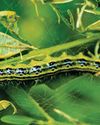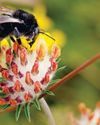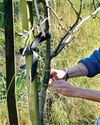
THERE is a well-worn and ancient joke that goes ‘What’s even worse than biting into an apple and discovering a maggot?’
The answer, of course, is ‘Half a maggot’, and early autumn is the time to be taking steps to ensure that fate doesn’t befall you next summer.
I found a little pink grub surrounded by lots of mess, or frass, in a greengage that I mercifully cut in half before eating.
This was a larvae of a plum moth and these are prevented in May by setting pheromone traps around your trees.
But there are several other moths, including the winter, burnt umber and March moth, that lay their eggs between November and May. The wingless females crawl up the trunks to lay their eggs on the branches, and the caterpillars emerge in spring.
These voracious grubs attack apple, plum, pear and cherry trees, chewing leaves, blossom and fruits and severely damaging and weakening trees.
This story is from the October 02, 2021 edition of Amateur Gardening.
Start your 7-day Magzter GOLD free trial to access thousands of curated premium stories, and 8,500+ magazines and newspapers.
Already a subscriber ? Sign In
This story is from the October 02, 2021 edition of Amateur Gardening.
Start your 7-day Magzter GOLD free trial to access thousands of curated premium stories, and 8,500+ magazines and newspapers.
Already a subscriber? Sign In

To dig or not to dig?
Should we be carrying out a full dig on plots now? Bob considers the pros and cons of the 'autumn dig' debate

The box ball blues
As if his beleaguered box hadn't already taken a beating, Toby now has to deal with some hungry box caterpillars

Save your own seeds
Masterclass on: seed saving

Strange sightings
Three unusual insects turn up in Val's garden in one day

A bolt from the blue!
Cornflowers are perfect for garden and vase

Winter moth prevention
Ruth shows you how to avoid maggoty tree fruits

Create a winter container
There are as many options as in summer

Lightweight gardening tools
AS well as being good for our mental health, gardening is also great exercise.

Autumn price round-up
AG finds better bargains in lesser-known brands

Rudbeckias
Rudbeckias are ideal for sunny summer patios and borders, with some able to survive our coldest winters